The Italian word for history is La Storia, the same word for the english us for a story. The truth is not in the facts, it’s in the telling. Here are some of the great stories (and facts) from our visit to Rome 14-20 August, 2009.
We’ve rented a beautiful apartment on Via del Gesu, a 3 minute walk from the Pantheon. At night, when it cools off a bit, we sit on the deck and watch the view of the rooftops, the dome of the Pantheon and St Peter’s Cathedral and listen to the live music at a rooftop restaurant a few hundred meters away. “Besame, Besame Mucho….”
On the walk to the Pantheon, about 3 minutes away, we cross through the Piazza Della Minerva. I literally almost ran over Ron Wood of the Rolling Stones and his Russian girlfriend. We had a small stop and chat and went on with our days. All I can say is that the media has not been very friendly to either of them. They both looked happy, healthy and much shorter than I thought.
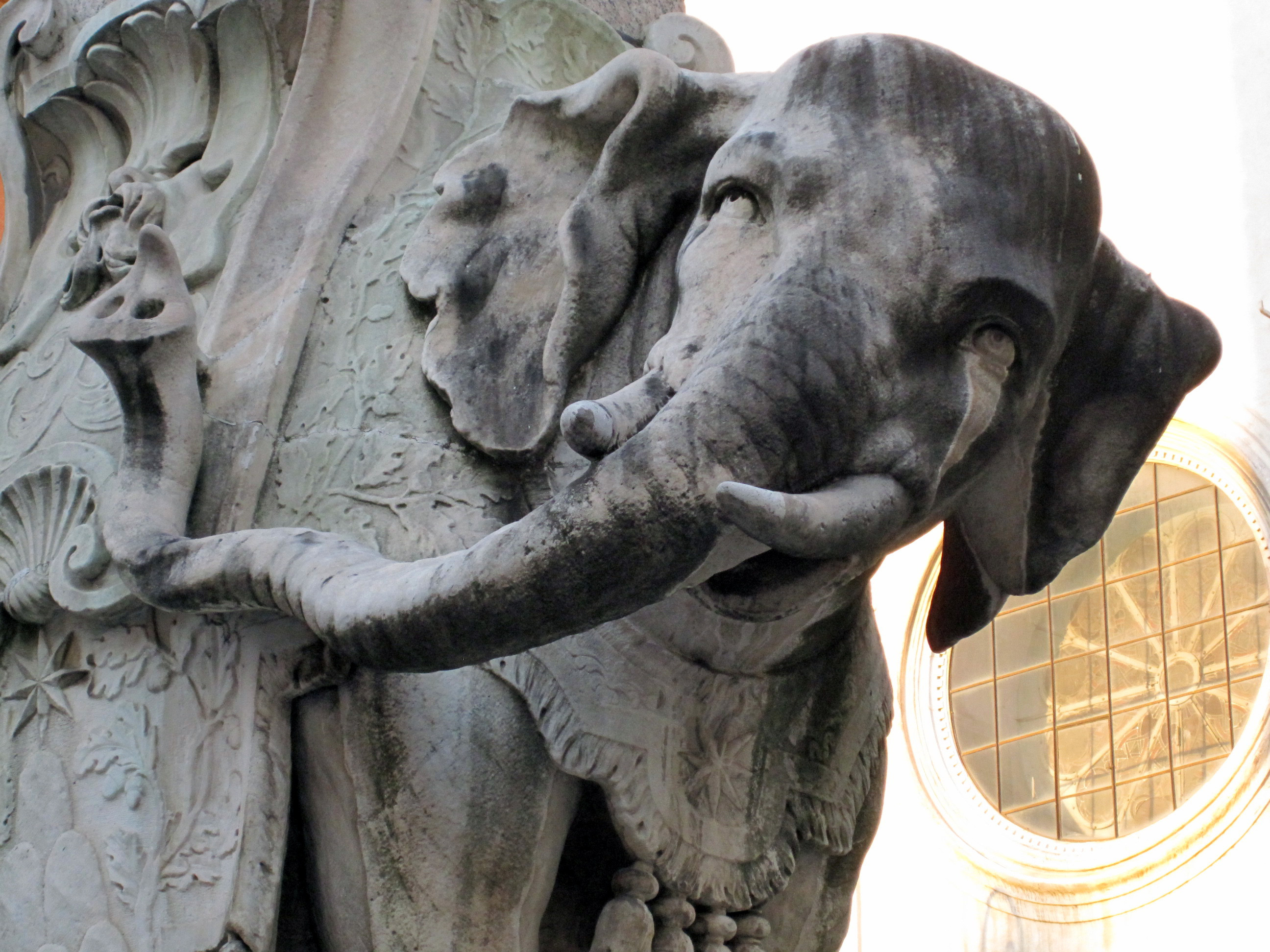 The elephant holding up an obelisk in the Piazza Della Minerva was crafted by Giovanni Lorenzo Bernini. It’s nickname is “Il Pulcino” because the Obelisk is short. A pulcino in Italian is a little chick.
The elephant holding up an obelisk in the Piazza Della Minerva was crafted by Giovanni Lorenzo Bernini. It’s nickname is “Il Pulcino” because the Obelisk is short. A pulcino in Italian is a little chick.
The Church behind Il Pulcino is the Santa Maria sopra Minerva (Santa Maria above Minerva) because it was always believed the church was built over a Temple to Minerva. In a recent revision of history, the historians now believe it was actually the ancient Temple to the Goddess Isis. It stood in the Egyptian neighborhood of the ancient city.
Santa Maria sopra Minerva is considered the only Gothic Church in Rome. It also houses the remains of Catherine of Siena, who died in the church of a stroke at age 33. Some of the devout people of Siena wanted to bring the body back to their Basilica di San Domenico but the Roman Domenicans wanted to keep her in Rome .
As the story goes, the Sienese figured out that they couldn’t get away with stealing the entire body, so they opted for just a few parts, the head and a thumb to be exact.When they were stopped at the gates of Rome and searched, they prayed to Catherine for help so they wouldn’t be caught. And when the Roman guard opened the bag that once contained the head and thumb, there was just a pile of rose petals. Catherine is sometime seen holding a rose.
When they got back to San Domenico of Siena, the rose petals turned back into the body parts. And there they are still on display today, the mummified head and thumb of St Catherine. The headless, thumbless body of the rest of Catherine is not on display at the Church of Santa Maria sopra Minerva.
Santa Maria sopra Minerva is also the location of the trial of Galileo Galilei. This is where he recanted his belief that the earth rotated around the sun after the Church pressured him into admitting they were correct in their theory that the world is “firmly establish and cannot be moved”. After he recanted his belief, according to legend, he whispered under his breath “ e pure si muove” (and yet it moves).
The Vatican Museums
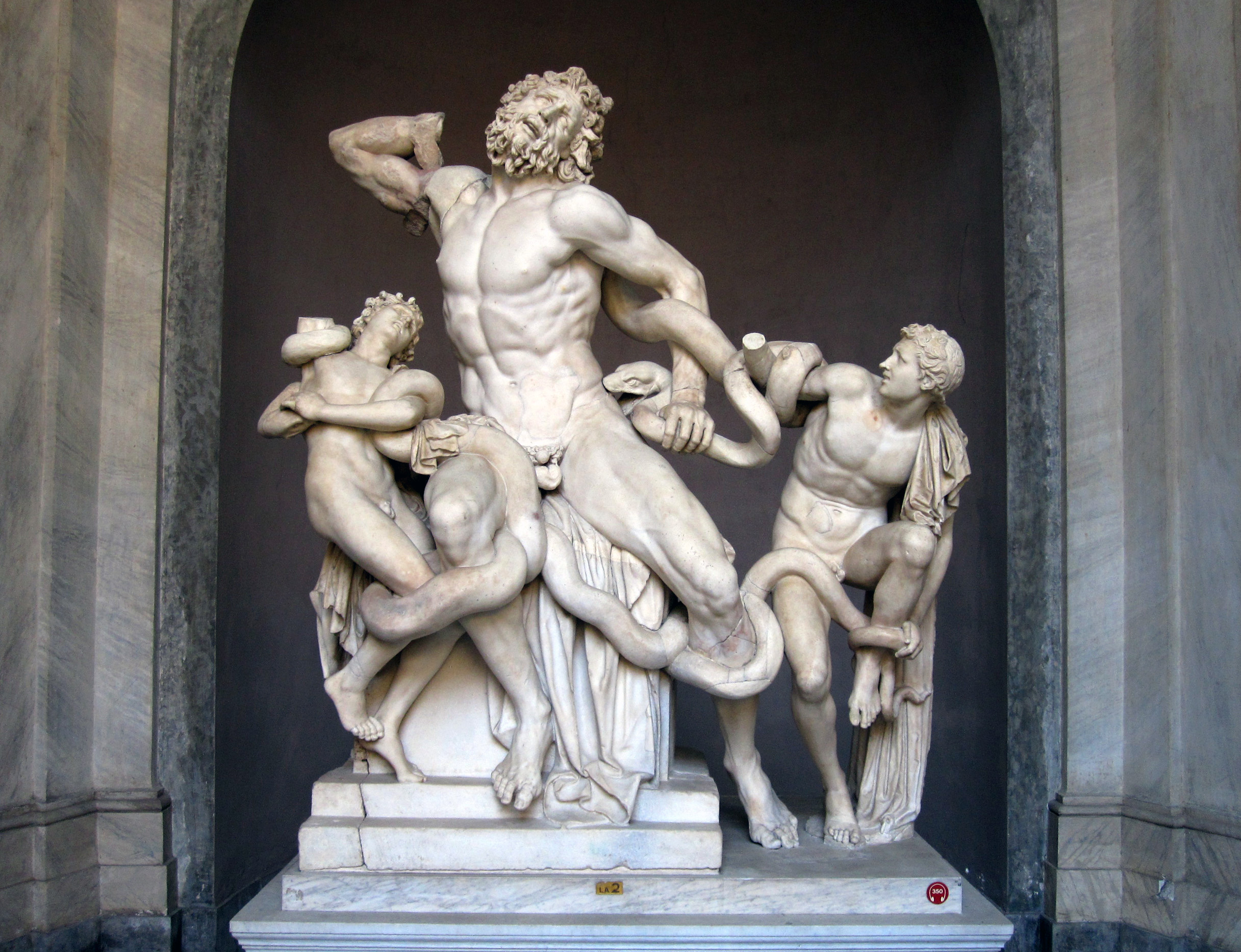 On January 14, 1506, a farmer named Felice da Fredis was digging up his vineyards in the Esquiline Hill and discovered a concealed chamber. When he broke through the chamber walls, he found the “Laocoon”, the statue of the priest of Troy who tried to warn his people not to accept the Greek Trojan Horse. The goddess Athena stopped him by sending seprents to devour Laocooön and his sons.
On January 14, 1506, a farmer named Felice da Fredis was digging up his vineyards in the Esquiline Hill and discovered a concealed chamber. When he broke through the chamber walls, he found the “Laocoon”, the statue of the priest of Troy who tried to warn his people not to accept the Greek Trojan Horse. The goddess Athena stopped him by sending seprents to devour Laocooön and his sons.
This was the statue described by Pliny as the great statue of ancient Rome, carved from one single block of stone in the 1st century BC by the three greatest artisans of Rhodes; Hegesander, Polydorus and Athenodorus. The staue was mostly in good condition and even though it was missing the right arm of Laocoön and the right hand of one of the sons, it immediately became one of the greatest treasures of the Vatican Museums.
When Pope Julius II got his hands on the 1st Century statue, he decided to repair the missing arms. Michaelangelo suggested that the missing arm of Laocoon should be bent back as if the Trojan priest was trying to rip the serpent off his back and even sculpted a rough version of the arm to show Julius how it would look. Raphael, on the other hand favored the left arm extending out straight in a heroic pose, or looking more like John Travolta in Saturday Night Fever. Raphael had a better argument and the straight arm was created and fitted.
In 1532, Pope Clement VII gave the commission to a pupil of Michelangelo named Montorsoli. Michelangelo refused to make a straight arm. It was fitted and stayed that way till 1957.
Now let’s back up about 50 years. In 1906 an archaeologist named Ludwig Pollack discovered a bent arm in one of his digs a short distance from where Felice da Fredis discovered the Laocoon in 1506. Convinced it was the missing arm to the Laocoon he presented it to the Vatican. They thanked him and put it in the basement until 1957 when some art historian fell across it and agreed it was indeed the right arm. The straight arm was removed, the new arm was fitted. The straight arm that Julius commissioned around 1506 was exiled to the basement. However, all the copies of the Laocoon made between 1506 and 1957 (and there are a few of them) still have the straight arm. There’s even one in the main entrance to the Vatican Museum.
The Vatican Museums are daunting and actually require at least three or four visits. If you spend one minute per item in the Vatican Museums it would take 14 years to see the entire collection and that doesn’t include the stuff they keep hidden in the basement. Afterall, the collection has been accumulating since 1506. Including the Sistine Chapel, there are 34 rooms of treasures. We suggest to buy your tickets online at the Vatican website.
We always enjoy walking through the Map Room of the Vatican Museum. Some of the continents and islands are drawn backwards and upside down because this is how the Pope would see them from his observatory in Rome, if the Pope could actually see the world from his observatory in Rome.
The Egyptian Book of the Dead is in the Vatican Museums, surrounded by a bunch of mummies and a 2000+ year old letter in it’s original envelope.
Giotto, the 14th century painter sometimes referred to as the father of Renaissance painting has a few pieces here. Giotto was the first and the first “Art Divo” of Italian painting. The classic story is when the Pope sent a messenger to Giotto to obtain a sample of his work, possibly for a future Papal project, Giotto pulled out a canvas, dipped his brush into some red paint and with the flick of his hand drew an absolutely perfect circle. When the messenger asked if that was all he would give, Giotto replied that it was all that was needed. The circle looked as if it was drawn with a compass. Giotto did get the commission from the Pope but his frescoes were destroyed when Pope Julius II tore down the old St Peter’s to build the one there now. However, Giotto’s gallery in the Vatican Museum is wonderful.
“Shushhhh” is apparently an Italian word. You’ll hear it a lot from the Museum guards of the Sistene Chapel. Talking is not allowed in the Chapel, partially out of respect and partially because loud noise can crack the stucco and the frescoes. However, if the decibel level does get too loud, it activates an automated recording (in several languages) to keep the noise down. The recorded message however, is louder than the noise level.
Michaelangelo worked (on and off) in the Sistene Chapel from 1508 to 1541. It’s said that after all those years of looking up at the ceiling his head was permantly bent and could only read by holding the book or manuscript over his head and looking up towards it. He died in 1564 at the age of 89 (just 3 weeks away from his 90th birthday). In 1565 the general feeling of the church was that the nude figures were a bit too bold and the artist Daniele da Volterra was brought in to paint fig leaves over many of the nudes of Michaelangelo’s ceiling. For his contribution, he was nicknamed “Il Braghettone” (the underpants maker).
A few months afterwards this alteration, the earth moved and put a big crack right down the center, cracking the image of god giving life to Adam with his outstretched finger. Now there’s a divine sign for you. A relatively unknown restorer from Modena named Domenico Carnevale was brought in to repair it. Yes, the most famous image of the fingers touching in the creation of Adam (now adorned on countless t-shirts) isn’t actually painted by Michaelangelo.
There have been lots of restorations to the ceiling. In 1797, parts of the ceiling fell in when a munitions dump exploded at the Castel Sant’Angelo. In the 1700’s some restorers were brought in to clean the ceiling. They used bread and greek wine. Then the entire ceiling was treated with animal glue in an attempt to seal it. Bad idea. In the late 1700’s more restorers came in with tempora, oil paint and crayons and painted on top of the animal fat sealer. The most recent restoration from 1984 to 1994 was done with a solution of sodium bicarbonate and ammonium bicarbonate, suspended in the gelatin (the geltin held the cleaning agent to the fresco so it would dissolve the animal glue). There was a lot of “discussion” about the restoration, but we think it was done extremely well. The colors are vivid and full of life, probably the way Michaelangelo intended.
In 1963 Pope John XXIII died. In 2000, he was beatified and as part of the ceremony his body was removed from the papal crypt under St Peter’s to the altar of St Jerome so the faithful could show their love and respect. When they opened the coffin, they found another miracle. The body of John XXIII didn’t decompose. The skin had turned yellow but he was all there, uncorrupted as they would say. After later examination the Vatican authorities found that the coffin had sealed his remains so tightly that no air was allowed. It was as if he was sealed in a vacuum. The fat of his body saponified (kind of turned to soap). And so now he lays in a glass coffin at the Altar of St Jerome. He looks like a wax replica but in fact it is the Soap Pope. We can only hope there isn’t a flood or massive water leak in the Cathedral. It would be a whole other meaning to cleansing the masses.
Love among the ruins
When Constantine moved the capital of the empire to his eastern city of Constantinople, he looted most of Italian Rome. When the Goths came in they took almost everything else. Over the next thousand years or so, the Romans used the ancient city to build a lot of the new city on top of the old one. By the early 18th century most of the ancient city was buried under 25 ft (or more) of civilization. Digs are happening all the time. The city is adding a new metro line (Linea C) in the historic zona. The have to dig down a minimum of 40’ to clear the ancient city, and of course, as soon as they hit an old column or pediment, they have to stop and bring in the archaeologists. This could take a while.
In the 1920s, the city municipal works was digging along the Corso Vittorio Emanuale II to put in an underground parking lot when they discovered ruins of oldest part of the ancient Forum, now called Largo Argentina. This was where Julius Caesar was assassinated. This is where Pompey built his theatre around 55 BCE. It was such an amazing find that the city destroyed all the medieval houses over the site and relocated all the residents.
You can go to either of the restaurants of Da Costanzo or Da Pancrazio on the Piazza Biscione, near the northwest corner Campo dei Fiori, and see some of the ruins of the Theatre of Pompey. They’re in the basement. The owners of the restaurants prefer you dine there first and then see the theater ruins later but if you’re nice they usually let you in without eating.
The Colosseum (or Flavian amphitheatre) was designed by a group of really clever architects. Unfortunately we only know the benefactor of the project. Vespatian paid for the Colosseum with the money he got from defeating the Judeans. Marcus Agrippa paid for the Pantheon. It sure would be nice to know more about the architects who designed these amazing structures.
The travertine marble blocks of the Colosseo were pinned together by large bronze pins so they wouldn’t move , kind of modern earthquake proofing. You can see lots of large holes in the stones dug by looters to get the valuable bronze.
The amphitheatre was built in just 8 years. We always thought it was built by a massive labor force but we just found out it was assembled with large counterweight machines.
 The inner circle of the football shaped amphitheatre is different from the shape of the outer circle creating a weight dispersion for extra stregnth. The walls are a mixture of travertine blocks and brick to create an elasticity against earthquakes. In fact, the 6.3 earthquake in L’Aquila on April 6th 2009, also shook Rome, 120 km away. Large modern apartment building in Rome shook and swayed but the Colosseum remained unmoved, just as it has for over 1900 years.
The inner circle of the football shaped amphitheatre is different from the shape of the outer circle creating a weight dispersion for extra stregnth. The walls are a mixture of travertine blocks and brick to create an elasticity against earthquakes. In fact, the 6.3 earthquake in L’Aquila on April 6th 2009, also shook Rome, 120 km away. Large modern apartment building in Rome shook and swayed but the Colosseum remained unmoved, just as it has for over 1900 years.
As a result of the weak economy of Italy these days, you can now rent the Colosseum for your own private party (wedding, bar mitzvah, rock concert). If you have the money, we have the antiquity. By the way, the acoustics are really good.
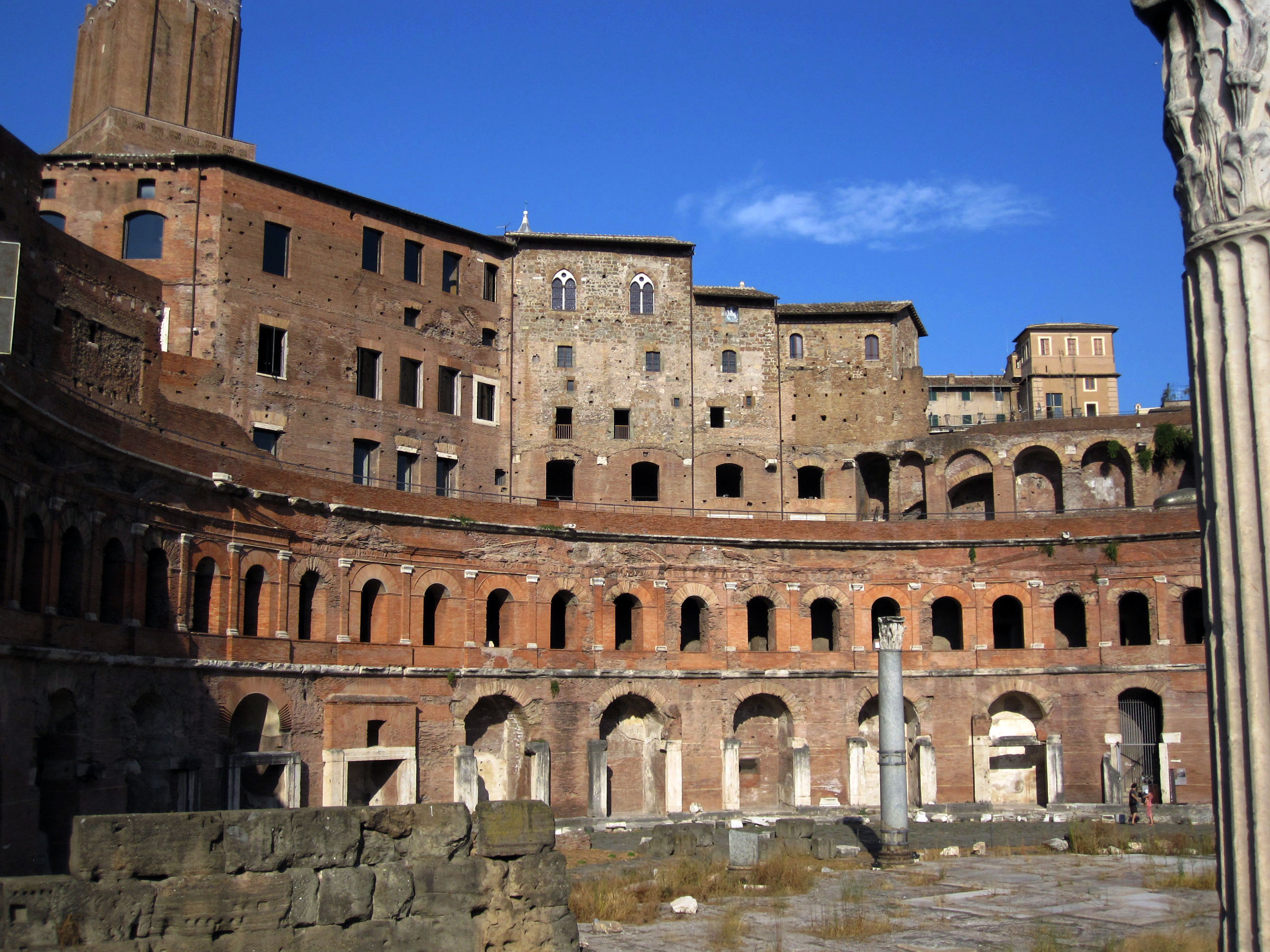
Trajan’s Market and Column are the only remains of what was once Trajan’s Forum, the largest Forum ever built in Rome, built with the treasure taken from the Dacians (modern day Romania) during the wars of 101-102 AD and again from 105-107AD. I read that the Dacian treasure trove included 180 tons of gold and twice as much silver and that didn’t include what was still in the ground. When Trajan returned for his Triumphal celebration he blessed the city with 123 days of games and festivities. Over 11,000 beasts and 5,000 gladiators gave their lives in honor of the celebration.
The marketplace offered free grain to the citizens in the grand piazza outside the market , while shops inside sold wine, oil, vegetables, meat, fish and prepared foods. There were offices in the top floors. This was the first known Mall in history.
In order to build the massive Forum, Apollodorus of Damascus, Trajan’s chief architect, had to remove 125′ of the Quirinale Hill, an estimated 20 million cubic feet of rock and dirt. The column’s height of 125’ was a reference to how tall the Quirinale used to be on the same spot.
Hadrian (Trajan’s successor) put Trajan’s ashes into a golden urn in the base of the structure, making the monument Trajan’s mausoleum. The column is made of 11’ diameter cararra marble drums, each one weighing over 40 tons. The center is carved out to fit a 185 step staircase from the base to the top. The exterior is carved with the story of the victory of Trajan’s forces over the Dacians.
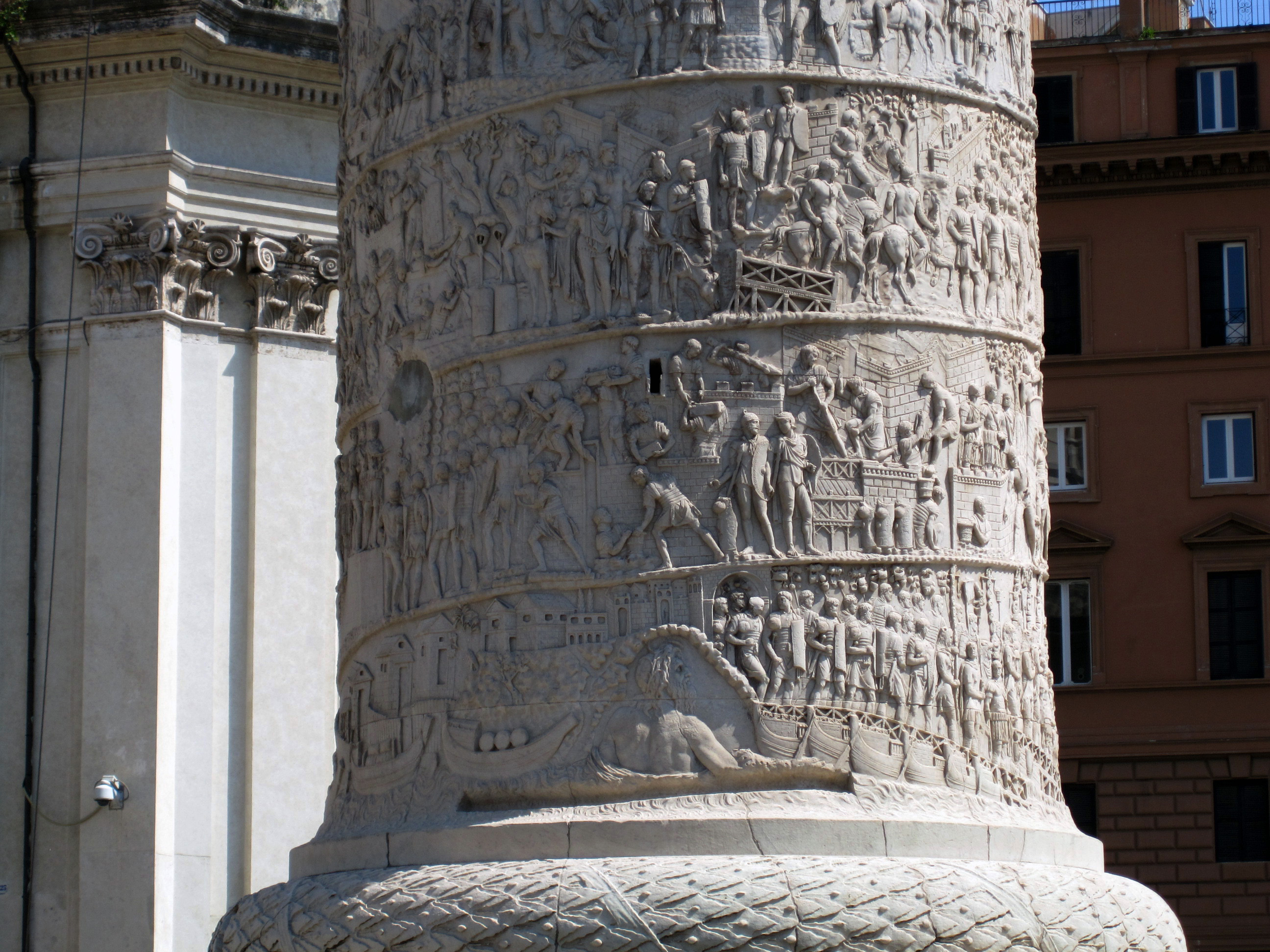
At the base of the column you can see the bridge designed by Apollodorus crossing the Danube, depicted by the Danube river god. On the top of the column stood a large golden statue of Trajan which “mysteriously disappeared”. It was replaced with the current statue of St Peter by Pope Sixtus V in 1588. Although all the other triumphal propagando columns were torn down and thrown in the lime kilns, two of them were saved for the statutes of Saints Peter and Paul. Peter sits on top of Trajan’s column and Paul on top of the column of Marcus Aurelius in Piazza Colonna on via del Corso. There used to be 2 grand libraries on either side of Trajan’s column containing many scrolls (volumes) of historical documents. If they were around today we’d have a lot better understanding of what ancient Rome was really like but they burned down. When the city’s on fire, the libraries go up pretty fast.
The marketplace contained 150 shops. The entire structure was created with concrete and covered with red brick, a nice balance to the dazzling colorful marble of the rest of the Forum.
Galleria Borghese
When you’re lost and you have to meet an art historian in less than 10 minutes, get Gretchen to ask directions from the Police. The last time I leaned out of the car to ask an Italian cop directions, we were pulled over in Bologna and fined for not having the proper international driving permit. Gretchen asked the local polizia how to get to the Galleria Borghese and they drove us there. The back seat of an Italian Police car is barely big enough to fit one human. Luckily the ride was only a few minutes. One of the police referred top Gretchen as “Lusinga” or a persuader.
The Galleria Borghese was built to look like a country villa but no one ever lived there. It was built to house the Schipione Borghese art collection. Thanks to the Papal practice of nepotism (nepote is nephew in Italian) Schipione was awarded the position of Cardinal in the church by his uncle Pope Paul V (Borghese). Thanks to the family influence and wealth, his art collection was the best in Rome.. Scipione was a patron of both Bernini and Caravaggio and consequently there are some of the best works of these artists still on display in the Galleria Borghese.
In one story, when the “fugitive on the run” Caravaggio begged Scipione to speak to his uncle the Pope to let him return to Rome, Scipione wrote back that he had arranged for a boat to arrive to Naples to transport both Caravaggio and his paintings back to Rome. Caravaggio and canvases boarded the ship but the instead of arriving to Rome, they docked much further up the Tuscan coast. When the boat did arrive to Rome, Caravaggio’s canvases were still on board. Caravaggio was not. Some say he got off the boat for a while and when he returned to the dock he saw the boat sailing away without him. Instead of catching the ship, he caught malaria and died at age 39. The other story is that Scipione Borghese never really wanted the troublesome Caravaggio back in Rome but he did really like his paintings.
Three of the finest examples of Bernini’s genius (“The Rape of Proserpine”, “David “ and “Apollo and Daphne”) are here at the Borghese and all three were made at the same time between 1621 and 1625. The statue of David slinging the stone at Goliath was completed in just 7 months in 1623.
You’re only allowed 2 hours to visit the Borghese museum. Either try to see as much as you can or make a couple of visits. This was our third.
If you have the time, take a walk up to the Aventine Hill. It’s one of the most beautiful parts of the city with quiet streets, great views and The Embassy of the Knights of Malta.
There aren’t any Knights of Malta in Malta anymore. These are the distant connection to the last surviving Knights of the Crusades. The Italian state recognizes their sovereignty. There are actually three nations within Rome (Italy, the Vatican, and the Knights of Malta). Supposedly when one becomes a Knight of Malta they take on a complete vow of chastity. Not that great a tradeoff.
The keyhole of the main gate to the embassy has become one of the hidden secrets of Rome. Small tour buses come by the dozens every day so people can get a peek through the keyhole and see a garden path that ends with bushes perfectly framing the dome of St. Peter’s way off the distance.
The push each other to see through the keyhole, then shrug their shoulders and get back on the bus. It’s a clever design but the tour books make it sound much more exciting. However, it does get you up to the Aventine Hill which is a real treat.
 The Jewish Ghetto
The Jewish Ghetto
The Jewish community has been in Rome since the 1st century BC, close to 2000 years. They’ve been an integral part of the city. However, in 1554, Pope Paul VI decided in his Papal Bull that “it would be absurd and inconvenient for Jews and Christians to live together.” He walled in the Jewish Quarter and locked the gates at night. He also forced the Jews to pray at a Catholic church with a sign above the door written in Hebrew on one side and Latin on the other. The signs misquotes a biblical reference where Jews are scolded for worshiping a false god. Paul VI used the reference to tell the Jews they were committing a sin by not worshipping Jesus Christ. And so he made them attend Catholic services every Sabbath. Luckily the Jewish congregants discovered wax earplugs.
In 1900, King Vittorio Emmanuele II tore down the ghetto walls and gave the Jewish community permission (and funds) to build a great synagogue anywhere they wanted in the city. The community chose a spot along the Tiber in the old Jewish Ghetto. They also chose to make the dome one of the tallest buildings in the area, signifying they didn’t need to hide any longer. The building has the only square dome in the city.
Trastevere
During ancient times the Trastevere was another small neighborhood connected across the Tiber by two bridge built by Cestio and Fabricio. Both met on the Isola Tiberina. Both bridges still stands today.
During Raphael’s days, the Trastevere was the home to his girlfriend, Margherita Luti, a baker’s daughter from Siena. In the 1990’s it became the hip, bohemian section of Rome. There is one main street, the Vialle di Trastevere, but the rest of the area is filled with small streets, cafes, bars, churches , boutiques and souvenir shops; kind of the like the rest of Rome on a smaller more intimate scale.
 The Church and Convent of Santa Cecilia in the Trastevere are definitely worth the visit. The Benedictine/Convent houses some of the best 14th century frescos in all of Rome, painted by Pietro Cavalini a contemporary of Giotto. The entrance to the Benedictine (with door buzzer/intercom) is to the left of the Church. Just ring the buzzer. There is a charge to go down and see the frescoes but it is well worth the price. You are literally standing right next to them. The sisters of Santa Cecilia will also try to sell you their handmade jams and soaps but they’ll understand and smile if you don’t buy them.
The Church and Convent of Santa Cecilia in the Trastevere are definitely worth the visit. The Benedictine/Convent houses some of the best 14th century frescos in all of Rome, painted by Pietro Cavalini a contemporary of Giotto. The entrance to the Benedictine (with door buzzer/intercom) is to the left of the Church. Just ring the buzzer. There is a charge to go down and see the frescoes but it is well worth the price. You are literally standing right next to them. The sisters of Santa Cecilia will also try to sell you their handmade jams and soaps but they’ll understand and smile if you don’t buy them.
Saint Cecilia was a Roman woman who let Christians use her house for prayer meetings. When her deeds were discovered by Roman soldiers, first they tried to boil her to death in her steam room. That didn’t work. Then, a Roman soldier hacked at her neck trying to cut if off. After three attempts she was still alive. The soldier ran off. Cecilia eventually died three days later and was buried with other early Christians in the Catacombs of San Callisto out on the Appian Way.
When she was exhumed a few hundred years later, it was discovered that her body did not deteriorate. It was in “perfect condition”, as if she was just put down to rest. She was returned to the Trastevere and in her honor the Church of Saint Cecelia was built over her house.
In the 16th century she was exhumed again when the church was updated. The corpse was still uncorrupted. This time they called in a sculptor who captured her death pose in marble. Cecilia was put back in the ground and the statue of her rests in front of the altar. By the way, Cecilia is the patron saint of music.
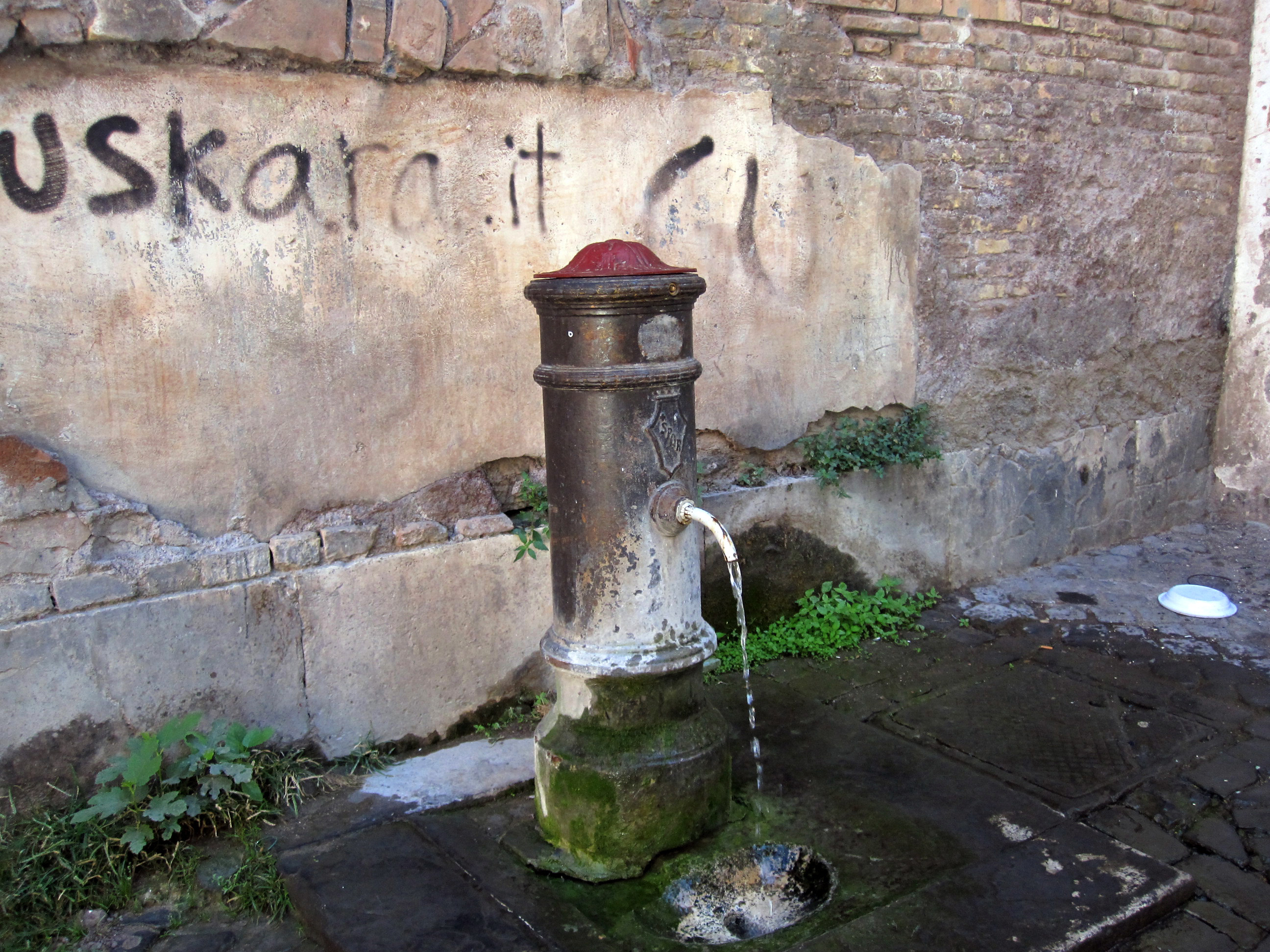 San Francisco is cold and windy in the summertime and it’s usually when we love to get out of the cold city in over to Rome, which is sometimes too hot. However, there are water fountains everywhere. The water comes from a mountain source somewhere nearby.It’s clean delicious mountain spring water and it never stops. There are lots of fountains are hundreds of the non stop water spigots all over the city. It’s weird coming from a drought stricken California to see the water running like this but this Rome, not California.
San Francisco is cold and windy in the summertime and it’s usually when we love to get out of the cold city in over to Rome, which is sometimes too hot. However, there are water fountains everywhere. The water comes from a mountain source somewhere nearby.It’s clean delicious mountain spring water and it never stops. There are lots of fountains are hundreds of the non stop water spigots all over the city. It’s weird coming from a drought stricken California to see the water running like this but this Rome, not California.
Urban Renewal in the Piazza della Rotonda
The most peaceful place in all of Rome is inside the Pantheon in the Piazza della Rotonda. Maybe it’s the building, maybe the dome itself (20’ thick on the bottom and 4’ thick on the top). If you want a lift of spirit and energy, go to the center of the Pantheon. It’s been a very spiritual place for over 2000 years.
It’s kind of funny though, outside of the monument is one of the most chaotic places in all of Rome; street artists, amplified musicians, street vendors, souvenir shops, cafes, restaurants and a horde of tourists.
The Piazza was th elocation of the city meat market stalls till the 18th century You can still see notches in the columns of the portico of the Pantheon where the stalls once existed. The market wasn’t the worst of it. The Piazza was alo the home of con men and scam artists from all over the city.
In the early 19th century, Pope Pius VII (Chiaramonti) decided to clean up the the area around the Pantheon. He removed the unsightly food stalls, opened up the center of the square and got rid of all the “hucksters”.
There is a plaque across the square from the Pantheon that translates to “we thank Pius for removing the ignoble shops and food stalls that ruined the air around the Pantheon.” What’s ironic about the sign is that is sits directly over the new “ignoble” McDonald’s .

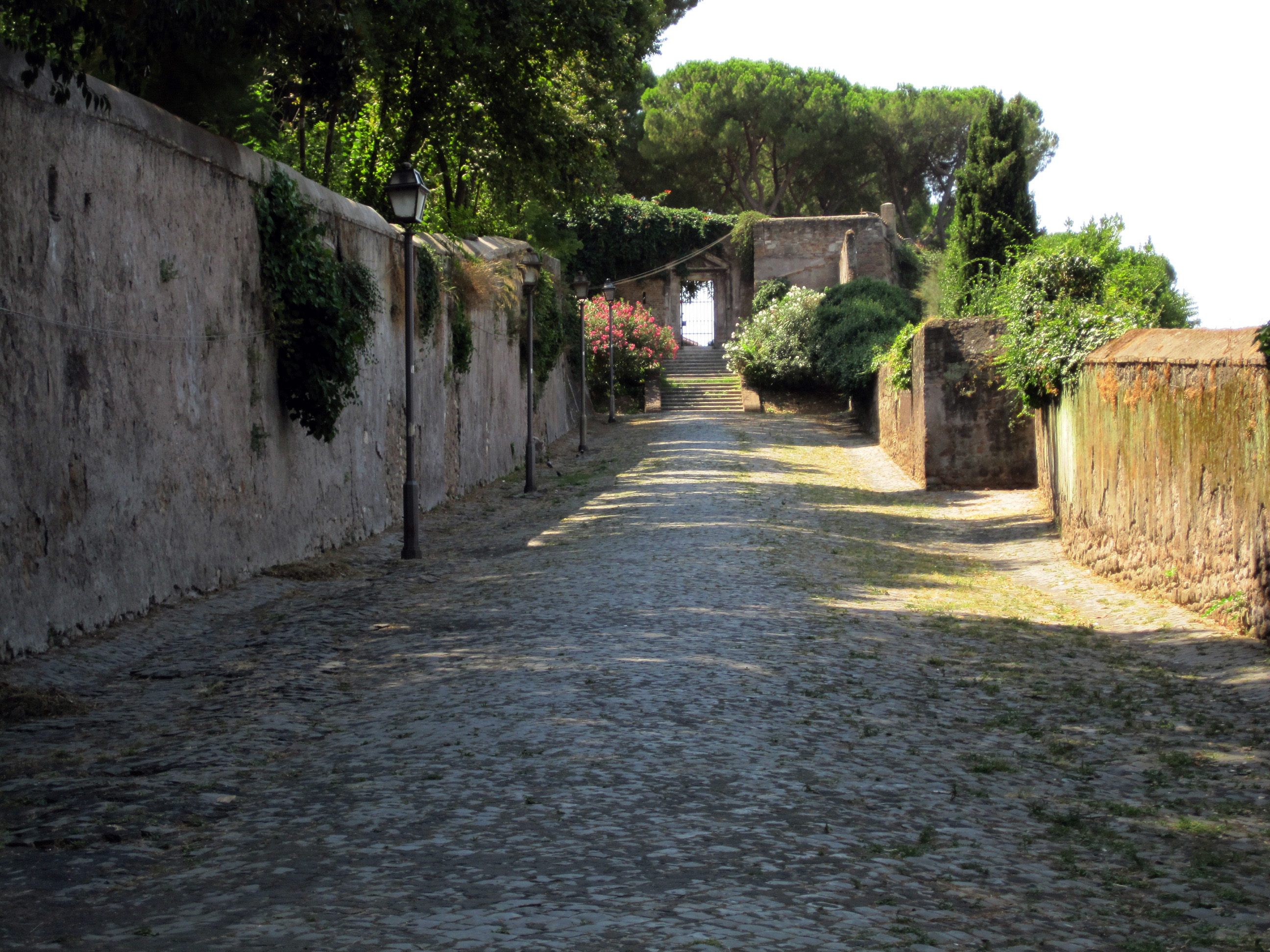
You must be logged in to post a comment.